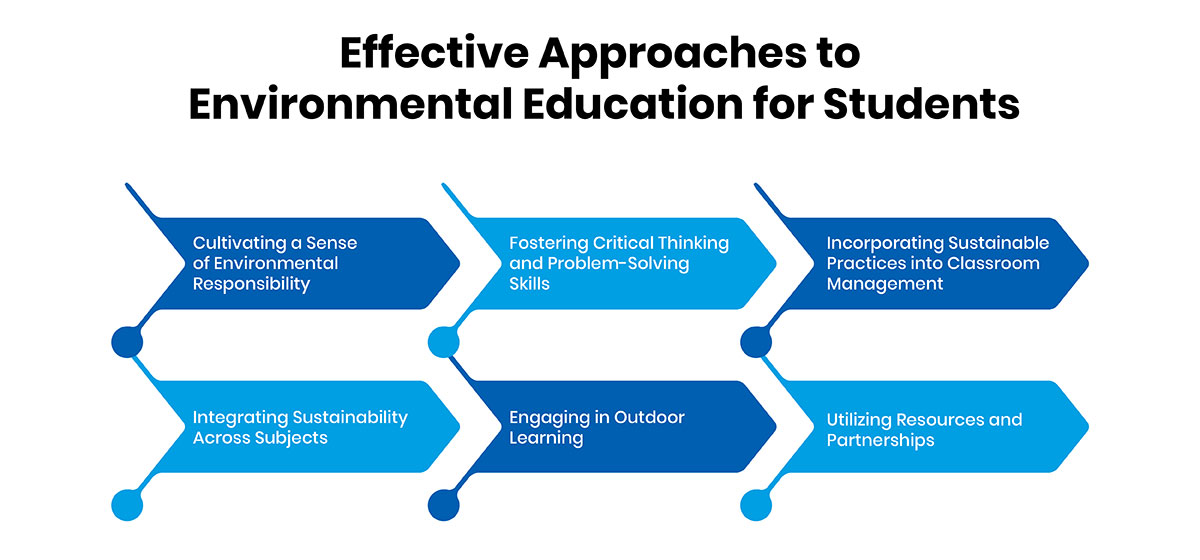Nurturing Eco-Conscious Minds: Environmental Education for a Sustainable Future
August 12, 2024Our planet is under significant strain from human activities such as fossil fuel consumption, deforestation, and industrial processes, leading to climate change, biodiversity loss, unsustainable land use, and resource depletion. Addressing these issues is imperative for our future.
Educators hold a unique and vital position in this endeavor. By embedding environmental education into school curricula, we can cultivate awareness from a young age, motivating individuals and communities to adopt sustainable practices. The urgency of global warming underscores the necessity of teaching children about environmental issues, enabling them to understand, appreciate, and actively contribute to sustainability efforts.
Equipping students with knowledge about climate change prepares them for future challenges and inspires them to take proactive steps to protect the environment. This article will explore the significance of environmental education in the classroom and provide practical strategies for incorporating sustainability and conservation principles into everyday teaching. By doing so, we prepare students to address environmental challenges and contribute to a more sustainable future.
Comprehending the Importance of Environmental Education
The significance of environmental education in tackling the ecological issues our planet encounters cannot be overstated. As the consequences of human activities—such as greenhouse gas emissions, deforestation, and industrial processes—continue to strain the environment, it is imperative to equip the younger generation with the knowledge and skills necessary to navigate these issues. By integrating environmental concepts and practices into school curricula, we can help students develop critical thinking skills, problem-solving abilities, and a deep connection to the natural world. This approach not only fosters a sense of responsibility towards the planet but also empowers students to become proactive agents of change.
Educators have a unique and vital role in this endeavor. By embedding environmental education into the classroom, they can raise awareness from an early age and inspire individuals and communities to adopt sustainable practices. This education promotes understanding of complex environmental issues like climate change, biodiversity loss, pollution, and resource depletion. It encourages students to think critically about these challenges and make informed decisions that positively impact the planet. Moreover, environmental education is essential for building resilience in a rapidly changing world. Through effective strategies, we can prepare each generation to contribute to a sustainable future where humanity coexists harmoniously with nature. By instilling a passion for sustainability, we pave the way for a brighter, more environmentally conscious future.
Foundational Aspects of Delivering Environmental Education
A multidisciplinary approach towards environmental education integrates science, social studies, arts, and experiential learning to bring forth environmental awareness and appreciation. Here are the key aspects to consider when imparting environmental education:
-
Holistic Curriculum Integration:
Environmental concepts and principles are seamlessly incorporated into various subject areas, allowing students to explore the interconnectedness of ecological systems and human activities. Through hands-on activities, projects, and discussions, students gain a deeper understanding of environmental issues and their implications for society and the planet. This approach not only enhances knowledge but also encourages critical thinking and problem-solving skills. -
Experiential Learning:
Recognizing the power of experiential learning, schools provide opportunities for students to engage directly with the natural world. Field trips, nature walks, and outdoor learning experiences enable students to connect with their environment, observe ecological processes firsthand, and develop a sense of stewardship and responsibility for the Earth. These experiences are crucial in helping students appreciate the beauty and complexity of nature and understand the importance of conservation. -
Learning Through Projects:
Project-based learning empowers students to take ownership of their education and apply their knowledge and skills to real-world environmental challenges. Environmental projects, such as waste reduction campaigns, energy conservation initiatives, and community gardening efforts, allow students to develop creativity, collaboration, and problem-solving skills while making a tangible impact on their school and community. This hands-on approach not only reinforces theoretical knowledge but also inspires proactive environmental action. -
Eco-Friendly Initiatives:
Beyond the classroom, schools must commit to implementing sustainable practices and reducing their environmental footprint. From energy-efficient infrastructure and waste reduction programs to water conservation measures and eco-friendly transportation options, schools serve as models of environmental stewardship and sustainability for students and the broader community. By practicing what they preach, schools instill values of sustainability in their students, encouraging them to carry these principles into their future lives and careers. -
Collaborations with Community and Industry:
Collaborating with local environmental organizations, businesses, and government agencies can enhance the educational experience. These partnerships provide practical experiences and expertise, fostering a sense of community involvement and shared responsibility for the environment. Schools can organize events, workshops, and initiatives that bring together students, teachers, and community members to work towards common environmental goals. -
Integration of Technology:
Utilizing technology to enhance learning is another vital aspect. Schools can incorporate digital tools such as simulations, virtual field trips, and interactive online platforms to provide a richer and more engaging educational experience. Access to digital resources allows students to conduct research, collaborate with peers, and present their findings on environmental topics, preparing them for a tech-savvy future. -
Teacher Training and Professional Development:
To ensure the effectiveness of environmental education, schools must invest in ongoing training for educators. Providing teachers with up-to-date knowledge on environmental issues, teaching strategies, and educational resources enables them to deliver high-quality instruction. Continuous professional development ensures that educators remain informed and inspired, fostering a culture of lifelong learning and environmental advocacy.
By integrating these foundational aspects, schools can create a comprehensive and impactful environmental education program that prepares students to understand and address the pressing environmental issues of our time.
Effective Approaches to Environmental Education for Students
Consider the following strategies to enhance student engagement and environmental awareness through effective educational approaches.

-
Cultivating a Sense of Environmental Responsibility
Developing a connection between students and nature is essential to instill a sense of environmental responsibility. By integrating sustainability practices into daily routines and promoting initiatives like waste reduction and recycling, we can empower students to become proactive guardians of the Earth. Interactive discussions, engaging activities, and thought-provoking assignments help kindle environmental consciousness. Highlighting success stories of individuals who have made significant ecological contributions can inspire students to take action themselves. -
Fostering Critical Thinking and Problem-Solving Skills
Guiding students through the process of gathering information, analyzing data, and proposing solutions cultivates their critical thinking abilities. This approach not only deepens their understanding of environmental issues but also equips them with essential problem-solving skills applicable beyond the classroom. Integrating project-based learning enables students to address real-life challenges collaboratively, instilling a sense of ownership and enthusiasm as they witness tangible results that positively impact their surroundings. -
Incorporating Sustainable Practices into Classroom Management
Creating a sustainable classroom environment involves modeling sustainable practices in our daily routines. From reducing waste and conserving energy to implementing recycling programs and using eco-friendly materials, educators can demonstrate the importance of conscious choices that minimize our ecological footprint. This approach extends beyond teaching about the environment to embodying sustainable living in everyday actions. -
Integrating Sustainability Across Subjects
Environmental education can be seamlessly integrated into various subjects, including science, social studies, language arts, and even mathematics. By incorporating sustainability-related topics and projects into lessons, educators help students make connections between their academic learning and real-world environmental issues. This interdisciplinary approach ensures that students see the relevance of environmental education in all areas of their lives. -
Engaging in Outdoor Learning
Taking learning beyond the classroom walls and into nature provides students with firsthand experiences and a deeper understanding of the environment. Field excursions, exploring nature firsthand, and conducting practical experiments enable students to connect with their environment, cultivate a sense of awe and respect for nature, and observe how human activities affect the natural world. These experiences build a lasting connection to the natural world. -
Utilizing Resources and Partnerships
Numerous resources and organizations are dedicated to supporting environmental education. Collaborating with local environmental agencies, inviting guest speakers, and accessing online platforms and educational materials can enrich teaching and expose students to a broader range of perspectives and knowledge about environmental issues. Partnerships with organizations can provide valuable resources and support for effective environmental education.
Conclusion
Environmental education emerges as a vital catalyst for nurturing a generation equipped to address the planet's pressing ecological issues. Through innovative teaching approaches and community collaborations, we inspire a collective commitment to safeguarding Earth's biodiversity and resources for a sustainable future.
By prioritizing environmental education and integrating sustainability and conservation principles into teaching, we equip students with the knowledge, skills, and values needed to address present and future environmental challenges.
Latest
Trends blogs
- The Next Wave: Emerging Trends in E-Learning by 2025
- The Role of Gamification in Education and Learning
- Artificial Intelligence: The Influence on Academic Frontiers
- Cybersecurity In Education: Building Resilient Institutions
Focus blogs
- Hybrid Learning Essentials: Preparing Students for the Future of Education
- Enhancing Learning Outcomes: Strategies for Achieving Academic Excellence in Students
- Building a STEM-Driven Future: Strategies to Enhance Educational Engagement
- The Need for Competency-Based Learning in Higher Education Institutions




